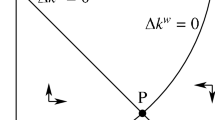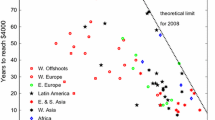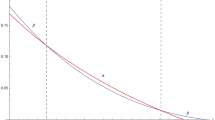Abstract
We incorporate the external effects of capital in production and endogenous technology choice into the standard overlapping generations model. We demonstrate that our model can exhibit a poverty trap, a middle-income trap, and perpetual growth paths. We also show that, under some economic conditions, an economy exhibits all three of these phenomena, depending on its initial capital level, and that the economy caught in the middle-income trap can exhibit chaotic fluctuations in the long run. This is a stark contrast to the result obtained by Umezuki and Yokoo (J Econ Dyn Control 100:164-175, 2019a) that we cannot observe any chaotic fluctuations. Because the model of Umezuki and Yokoo (2019) is a special case of our model in the sense that there is no externality in production, our result means that we need the combination of technology choice and externalities in production to obtain chaotic fluctuations in the standard overlapping generations model with Cobb-Douglas technologies.

















Similar content being viewed by others
Data availability
No datasets were generated or analyzed during the current study.
Notes
In endogenous business cycle theory, economic fluctuations occur spontaneously as a result of nonlinear factors within the economy, without any shocks from outside the economy. Early studies in this line include Benhabib and Day (1982), Grandmont (1985), Benhabib and Nishimura (1985), and Nishimura and Yano (1995).
Iwaisako (2002) is an exception. He considered two possible technologies: a constant returns to scale technology and an increasing returns to scale technology. However, he relied exclusively on graphical analysis.
In general, external effects or externalities mean that the action of an agent affects other agents’ costs or benefits without going through the market transactions. For example, knowledge accumulation has positive externalities for society (e.g., newly obtained mathematical theorems are freely available to everyone). On the other hand, crime is an example of a negative externality with social costs.
For example, see Azariadis and John (2005) for a survey.
As a recent theoretical work, Hu et al. (2022) show that the degree of externalities plays a significant part in technology choice and makes it possible to explain the empirically observed development patterns (a poverty trap, a middle-income trap, and a flying geese pattern of economic development) in a unified way. See also Asano et al. (2022a) and references therein for details.
This means that even if the degree of external effects observed on average in the economy is relatively small, we can have chaotic fluctuations, because, in our model, the selected technology continues to switch between technology with externalities and that without externalities.
Regarding another possible interpretation, we may assume that the firm chooses its production technology in a discrete manner in the first stage and then chooses optimal inputs in the second stage.
Several studies measure external effects by estimating the percentage increase in a firm’s output caused by a 1% increase in aggregate inputs (or aggregate output), keeping an individual firm’s inputs unchanged. Caballero and Richard (1989), Caballero and Richard (1992)) estimated the external effect in the US manufacturing industry and obtained values ranging from 0.49 to 0.89 and from 0.32 to 0.49 in their 1989 and 1992 studies, respectively. Caballero and Lyons (1990) also provided estimates for European countries ranging from 0.29 to 1.40. Moreover, the values estimated by Lindström (2000) for Swedish manufacturing range from 0.16 to 0.53. By contrast, using the industry-level manufacturing data for the United Kingdom, Oulton (1996) found no evidence of either external effects or increasing returns to scale. These results show that the degree of external effects varies across countries and industries.
Let I be a compact interval and \(f:I\rightarrow I\) be a piecewise-smooth map \(x_{t+1}=f(x_{t})\). The Lyapunov exponent \(\lambda\) of f on I is defined by
$$\begin{aligned} \lambda =\lim _{n\rightarrow \infty }\frac{1}{n}\sum _{t=0}^{n}\log |f^{\prime }(x_{t})|,\quad \text { whenever the derivative exists}. \end{aligned}$$If the Lyapunov exponent is positive, then the map is chaotic in the long run.
References
Aghion P, Banerjee A, Piketty T (1999) Dualism and macroeconomic volatility. Q J Econ 114(4):1359–1397
Asano T, Kunieda T, Shibata A (2012) Complex behaviour in a piecewise linear dynamic macroeconomic model with endogenous discontinuity. J Differ Equations Appl 18(11):1889–1898
Asano T, Akihisa S, Masanori Y (2022a) Middle-income traps and complexity in economic development. forthcoming in Studies in Nonlinear Dynamics and Econometrics
Asano T, Shibata A, Yokoo M (2022) Quasi-periodic motions in a two-class economy with technology choice: an extreme case. Nonlinear Dyn 110:945–961
Asano T, Shibata A, Yokoo M (2022c) “Technology choice, externalities in production, and chaotic middle-income traps.” KIER Discussion Paper No. 1075, preprint. https://www.kier.kyoto-u.ac.jp/wp/wp-content/uploads/2022/03/DP1075.pdf
Azariadis C, Stachurski J (2005) “Poverty traps.” In: Philippe Aghion, Steven N. Durlauf eds., Handbook of Economic Growth 1: 295-384
Azariadis C, Reichlin P (1996) Increasing returns and crowding out. J Econ Dyn Control 20(5):847–877
Baxter M, King RG (1991) Productive externalities and business cycles. Discussion paper/institute for empirical macroeconomics 53, Federal Reserve Bank of Minneapolis
Beaudry P, Galizia D, Portier F (2020) Putting the cycle back into business cycle analysis. Am Econ Rev 110(1):1–47
Benhabib J, Day RH (1982) A characterization of erratic dynamics in, the overlapping generations model. J Econ Dyn Control 4:37–55
Benhabib J, Nishimura K (1985) Competitive equilibrium cycles. J Econ Theory 35:284–306
Caballero RJ, Lyons RK (1989) “The role of external economies in U.S. manufacturing.” NBER Working Paper No. 3033
Caballero RJ, Lyons RK (1990) Internal versus external economies in European industry. Eur Econ Rev 34:805–830
Caballero RJ, Lyons RK (1992) External effects in U.S. procyclical productivity. J Monetary Econ 29:209–225
Deng L, Fujio M, Khan MA (2021) Eventual periodicity in the two-sector RSL model: equilibrium vis-à-vis optimum growth. Econ Theory 72(2):615–639
Diamond PA (1965) National debt in a neoclassical growth model. Am Econ Rev 55:1126–1150
Fujita M, Paul RK, Anthony JV (1999) The Spatial Economy: Cities, Regions, and International Trade , MIT
Fujita M, Thisse J-F(1996) Economics of agglomeration. J Jpn Int Econ 10(4):339–378
Gardini L, Sushko I, Naimzada AK (2008) Growing through chaotic intervals. J Econ Theory 143:541–557
Grandmont J-M (1985) On endogenous competitive business cycles. Econometrica 53:995–1045
Guckenheimer J, Holmes P (1983) Nonlinear Oscillations. Springer, Dynamical Systems and Bifurcations of Vector Fields
Hu Y, Kunieda T, Nishimura K, Wang P (2022) Flying or trapped?, Economic Theory, forthcoming https://doi.org/10.1007/s00199-021-01402-4
Ishida J, Yokoo M (2004) Threshold nonlinearities and asymmetric endogenous business cycles. J Econ Behav Organ 54(2):175–189
Iwaisako T (2002) Technology choice and patterns of growth in an overlapping generations model. J Macroecon 24(2):211–231
Klenow PJ, Andrés R-C (2005) Externalities and growth. In: Aghion P, Durlauf SN (eds) Handbook of economic growth, vol 1, pp 817–861
Lasota A, Yorke JA (1973) On the existence of invariant measures for piecewise monotonic transformations. Trans Am Math Soc 186:481–488
Lindström T (2000) External economies in procyclical productivity: how important are they? J Econ Growth 5:163–184
Lucas RE (1988) On the mechanics of economic development. J Monetary Econ 22:3–42
Matsuyama K (2007) Credit traps and credit cycles. Am Econ Rev 97(1):503–516
Kiminori M (2013) The good, the bad, and the ugly: an inquiry into the causes and nature of credit cycles. Theor Econ 8(3):623–651
Matsuyama K, Sushko I, Gardini L (2016) Revisiting the model of credit cycles with good and bad projects. J Econ Theory 163:525–556
Matsuyama K, Sushko I, Gardini L (2018) A piecewise linear model of credit traps and credit cycles: a complete characterization. Decisions Econ Finan 41(2):119–143
Moretti E (2004) “Human capital externalities in cities.” In: J. Vernon Henderson, Jacques-François Thisse eds., Handbook of Regional and Urban Economcis 4: 2243-2291
Negishi T (1969) Marshallian external economies and gains from trade between similar countries. Rev Econ Stud 36(1):131–135
Nishimura K, Yano M (1995) Non-linear dynamics and chaos in optimal growth: an example. Econometrica 63:981–1001
Oulton N (1996) Increasing returns and externalities in UK manufacturing: myth or reality? J Ind Econ 44(1):99–113
Romer PM (1986) Increasing returns and long-run growth. J Polit Econ 94(5):1002–1037
Stephanie S-G, Uribe M (2021) Deterministic debt cycles in open economies with flow collateral constraints. J Econ Theory 192:105195
Sushko I, Gardini L, Matsuyama K (2014) Superstable credit cycles and U-sequence. Chaos, Solitons & Fractals 59:13–27
Sushko I, Gardini L, Matsuyama K (2016) Robust chaos in a credit cycle model defined by a one-dimensional piecewise smooth map. Chaos, Solitons & Fractals 91:299–309
Umezuki Y, Yokoo M (2019) A simple model of growth cycles with technology choice. J Econ Dyn Control 100:164–175
Umezuki Y, Yokoo M (2019b) Chaotic dynamics of a piecewise smooth overlapping generations model with a multitude of technologies. Discussion Paper Series No. I-103, The Economic Association of Okayama University
Acknowledgements
The authors acknowledge an anonymous reviewer for comments on this paper. The authors would also like to thank Real Arai, Keita Kamei, and seminar participants at Seinan Gakuin University for their helpful comments and suggestions. This research was financially supported by International Joint Research Center of Advanced Economic Research of Kyoto Institute of Economic Research and the Grants-in-Aid for Scientific Research, Japan Society for the Promotion of Science (20H05631, 21K01388, and 23K01468).
Author information
Authors and Affiliations
Corresponding author
Ethics declarations
Conflict of interest
All of the three authors declare no conflict of interest.
Additional information
Publisher's Note
Springer Nature remains neutral with regard to jurisdictional claims in published maps and institutional affiliations.
This is a revised version of our preprint, Kyoto Institute of Economic Research (KIER) Discussion Paper No.1075, which is referred to in References (Asano et al. (2022c)).
Appendix
Appendix
Proof of Claim 2
Let \(\alpha _1A_1/\alpha _2A_2=1\) and \(1>\alpha _2>\alpha _1\). Then, all we need to show is that the following inequalities are possible:
Rewriting the above expression as:
we notice that \(\alpha _2/\alpha _1(1-\alpha _1)<1/(1-\alpha _2)\) always holds because \(\alpha _2>\alpha _1\). As \(sA_2\) can take any positive value, the claim is proven. \(\square\)
Proof of Lemma 2
Let \(\alpha _1A_1/\alpha _2A_2=1\) and \(1>\alpha _2>\alpha _1\). Then, the first inequality in condition (9) can be rewritten as:
Similarly, the second inequality in condition (9) is expressed as
Letting \(V=1/(1-\alpha _2)\) and \(W=\alpha _1/\alpha _2(1-\alpha _1)\), we observe that \(V>W\) because \(\alpha _2>\alpha _1\). Because \(sA_2\) can take any positive value, it suffices to show that \(V^{1-1/\beta _1}W^{1/\beta _1}<V^{\beta _2}W^{1-1/\beta _2}\) or \(V^\gamma <W^\gamma\), where \(\gamma =1-1/\beta _1-1/\beta _2\). Thus, the last inequality holds if \(\gamma <0\) or \(1/\beta _1+1/\beta _2>1\). \(\square\)
Proof of Lemma 3
Using the same notations as in the proof of Claim 2, it suffices to show that \(V^{1-1/\beta _1}W^(1/\beta _1)>V^{\beta _2}W^{1-1/\beta _2}\) or \((V/W)^\gamma >1\), where \(\gamma =1-1/\beta _1-1/\beta _2\). Because \(V/W>1\), the last inequality holds if we take \(\beta _1\) and \(\beta _2\) (\(\beta _2>\beta _1>1\)) such that \(\gamma >0\) or \(1/\beta _1+1/\beta _2<1\). \(\square\)
Proof of Lemma 4
Let \(s\in (0,1)\) and \(\alpha _2\in (0,1)\) (hence, \(\eta _2=\beta _2-\alpha _2\)) be fixed. Let \(a_i\) (\(i=1, 2\)) be any numbers such that \(1<a_1<a_2\). Let \(\alpha _1A_1/\alpha _2A_2=1\). Then, inequalities (15) and (16) can be reduced to:
Solving the following simultaneous equations for \(A_2\) and \(\alpha _1\),
we obtain:
which verifies the assertion. \(\square\)
Proof of Lemma 8
Let us begin with \(\tau _1(0)=1-c\beta _1>c\), which implies from Lemma 7 that any trajectory visits \(I_R\) at least once immediately after visiting \(I_L\). To ensure that the trajectory stays successively twice in \(I_R\), we require that:
To ensure that the trajectory stays in \(I_R\) successively at least three times, we have:
Repeating this up to n times, we obtain:
Solving the last inequality for c yields the result. \(\square\)
Proof of Proposition 8
Note that for the value of the threshold c in the assumption of the proposition to be taken, it must hold that:
This inequality is equivalent to \(\beta _1\beta _2<1+\beta _1\), which is assured by assumption. Because Lemma 7 indicates that any trajectory (i.e., irrelevant to the initial conditions) of \(\tau\) visits \(I_L\) successively at most once, it follows for any initial condition \(x_0\in (0,1)\) that:
where the last inequality follows by assumption. Thus, \(\tau\) is eventually expanding and hence chaotic in the sense of Lasota and Yorke (1973). By conjugacy h, T is also chaotic. \(\square\)
Rights and permissions
Springer Nature or its licensor (e.g. a society or other partner) holds exclusive rights to this article under a publishing agreement with the author(s) or other rightsholder(s); author self-archiving of the accepted manuscript version of this article is solely governed by the terms of such publishing agreement and applicable law.
About this article
Cite this article
Asano, T., Shibata, A. & Yokoo, M. Technology choice, externalities in production, and a chaotic middle-income trap. J Econ 141, 29–56 (2024). https://doi.org/10.1007/s00712-023-00844-9
Received:
Accepted:
Published:
Issue Date:
DOI: https://doi.org/10.1007/s00712-023-00844-9




